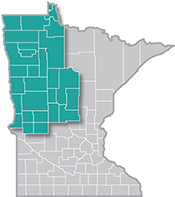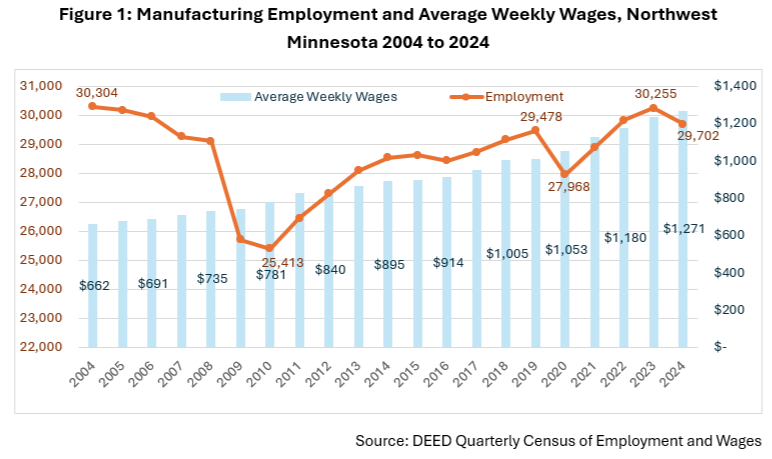 The presence of such industry powerhouses as Polaris, Arctic Cat and New Flyer make Northwest Minnesota a hub of transportation equipment manufacturing.
The presence of such industry powerhouses as Polaris, Arctic Cat and New Flyer make Northwest Minnesota a hub of transportation equipment manufacturing.
From wheat and potatoes to soybeans and sugar beets, the region is a major producer and processor of food staples and specialty agricultural products.
Want the freshest data delivered by email? Subscribe to our regional newsletters.
As October, Minnesota’s Manufacturing Month draws closer, Northwest’s Manufacturing industry continues to hold strong.
9/15/2025 11:40:37 AM
Anthony Schaffhauser
As October, Minnesota's Manufacturing Month draws closer, Northwest's Manufacturing industry continues to hold strong. The industry accounts for 13% of total jobs and 16% of total wages. The much higher-than-average wages reflect the high value added by this industry. In the Northwest region, manufacturing workers earn an average annual wage of $66,092, which is 24% higher than the $53,404 average across all industries combined.
Beyond individual paychecks, manufacturing plays a crucial role in regional economic development. As the Minnesota Chamber of Commerce states it, manufacturers have "an outsized impact on local economic growth, as they draw new money into the region from markets elsewhere rather than circulating it within a community." The large amount of revenue from sales outside the region make manufacturing particularly valuable for the regional economy.
Manufacturing bounced back impressively from the Pandemic Recession, exceeding 2019 employment levels in 2022 and continuing to grow through 2023 (Figure 1). The sector nearly reached its 2004 peak before the Great Recession's sharp decline that bottomed out in 2010. While employment dipped by 533 jobs (-1.8%) in 2024, it remains above pre-pandemic levels going all the way back to 2007.

Source: DEED Quarterly Census of Employment and Wages
The wage growth story is particularly compelling. Average weekly wages increased 25.5% from 2019 to 2024, outpacing inflation by 3.3 percentage points. Over the full 20-year period from 2004 to 2024, wages grew at an annualized rate of 3.3%, consistently beating inflation by 1% annually.
Northwest Minnesota stands out among the state's regions for manufacturing employment stability. From 2019 to 2024, the region added 224 manufacturing jobs (+0.8%), making it one of only two regions statewide to post employment gains. This growth is particularly notable when compared to other regions that experienced significant losses. Only Northeast Minnesota did better. Its faster employment growth generated 106 more jobs than the Northwest from a much smaller base.
| Table 1: Manufacturing Employment Trend by Region, 2019 to 2024 | ||||
|---|---|---|---|---|
| Region | 2019 | 2024 | 2019-2024 Change | |
| Jobs | Percent | |||
| Central Minnesota | 41,978 | 41,273 | -705 | -1.7% |
| Northeast Minnesota | 8,891 | 9,231 | 340 | 3.8% |
| Northwest Minnesota | 29,478 | 29,702 | 224 | 0.8% |
| Seven County Metro | 173,061 | 172,794 | -267 | -0.2% |
| Southeast Minnesota | 38,734 | 35,968 | -2,766 | -7.1% |
| Southwest Minnesota | 31,347 | 29,843 | -1,504 | -4.8% |
| Minnesota | 323,941 | 320,265 | -3,676 | -1.1% |
| Source: DEED Quarterly Census of Employment and Wages | ||||
While overall manufacturing employment remained stable, significant changes occurred within individual subsectors (Table 2). The largest subsector, Food Manufacturing, added the most jobs by far, followed by the second largest, Machinery Manufacturing. The fastest job growth occurred in Beverage & Tobacco Product Manufacturing (+48%) and Electrical Equipment, Appliance & Component Manufacturing (+37.8%).
| Table 2: Manufacturing Subsector Employment Trend, Northwest Minnesota 2019 to 2024 | ||||
|---|---|---|---|---|
| Industry Title | 2019 | 2024 | 2019-2024 Change | |
| Jobs | Percent | |||
| Food Manufacturing | 5,917 | 6,724 | 807 | 13.6% |
| Machinery Manufacturing | 3,984 | 4,206 | 222 | 5.6% |
| Transportation Equipment Manufacturing | 4,337 | 4,129 | -208 | -4.8% |
| Fabricated Metal Product Manufacturing | 4,164 | 4,039 | -125 | -3.0% |
| Wood Product Manufacturing | 3,407 | 3,278 | -129 | -3.8% |
| Printing & Related Support Activities | 1,262 | 1,315 | 53 | 4.2% |
| Plastics & Rubber Products Manufacturing | 922 | 993 | 71 | 7.7% |
| Computer & Electronic Product Manufacturing | 949 | 946 | -3 | -0.3% |
| Nonmetallic Mineral Product Manufacturing | 968 | 918 | -50 | -5.2% |
| Furniture and Related Product Manufacturing | 647 | 637 | -10 | -1.5% |
| Miscellaneous Manufacturing | 834 | 623 | -211 | -25.3% |
| Primary Metal Manufacturing | 648 | 470 | -178 | -27.5% |
| Beverage & Tobacco Product Manufacturing | 256 | 379 | 123 | 48.0% |
| Chemical Manufacturing | 412 | 368 | -44 | -10.7% |
| Textile Product Mills | 392 | 234 | -158 | -40.3% |
| Electrical Equipment, Appliance, & Component | 135 | 186 | 51 | 37.8% |
| Source: DEED Quarterly Census of Employment and Wages | ||||
Conversely, some subsectors faced challenges. Miscellaneous Manufacturing and Transportation Equipment Manufacturing lost the most jobs (-211 and -208 respectively), while Textile Product Mills and Primary Metal Manufacturing experienced the steepest percentage declines (-40.3% and -27.5% respectively).
Due to the size and growth, the manufacturing job market offers compelling opportunities for Northwest Minnesota job seekers. The 779 manufacturing job vacancies in 2024 carried a median wage offer of $22.74 – significantly higher than the $18.57 median wage offer for all job vacancies. Notably, only 22% of open manufacturing positions require education beyond high school.
Table 3 displays 15 selected manufacturing occupations offering a particularly attractive combination of strong demand, competitive wages and accessible education requirements. Specifically, these were selected with the Occupations in Demand Tool by filtering the manufacturing occupations that:
| Table 3: Selected Northwest Minnesota Occupations in Demand Found in the Manufacturing Industry | ||||
|---|---|---|---|---|
| SOC Code | Job Title | Median Wage | Education Requirements | Training Requirements |
| 41-4012 | Sales Representatives, Wholesale & Manufacturing, Exc. Technical and Scientific Products | $63,220/yr | High school diploma or equivalent | Moderate-term on-the-job training |
| 51-1011 | First-Line Supervisors of Production & Operating Workers | $72,611/yr | High school diploma or equivalent | Moderate-term on-the-job training |
| 51-4121 | Welders, Cutters, Solderers & Brazers | $51,974/yr | High school diploma or equivalent | Moderate-term on-the-job training |
| 51-4041 | Machinists | $51,108/yr | Postsecondary non-degree award | Long-term on-the-job training |
| 51-9061 | Inspectors, Testers, Sorters, Samplers & Weighers | $52,622/yr | High school diploma or equivalent | Moderate-term on-the-job training |
| 51-9124 | Coating, Painting, & Spraying Machine Setters, Operators & Tenders | $55,137/yr | High school diploma or equivalent | Moderate-term on-the-job training |
| 51-9023 | Mixing & Blending Machine Setters, Operators & Tenders | $50,228/yr | High school diploma or equivalent | Moderate-term on-the-job training |
| 51-4031 | Cutting, Punching, & Press Machine Setters, Operators & Tenders | $51,511/yr | High school diploma or equivalent | Moderate-term on-the-job training |
| 51-9161 | Computer Numerically Controlled Tool Operators | $50,099/yr | High school diploma or equivalent | Moderate-term on-the-job training |
| 43-5061 | Production, Planning & Expediting Clerks | $60,868/yr | High school diploma or equivalent | Moderate-term on-the-job training |
| 49-9041 | Industrial Machinery Mechanics | $62,013/yr | Postsecondary non-degree award | Long-term on-the-job training |
| 17-3026 | Industrial Engineering Technologists & Technicians | $61,026/yr | Associate's degree | None |
| 53-7051 | Industrial Truck & Tractor Operators | $47,379/yr | High school diploma or equivalent | Short-term on-the-job training |
| 49-9043 | Maintenance Workers, Machinery | $64,819/yr | High school diploma or equivalent | Long-term on-the-job training |
| 45-2041 | Graders & Sorters, Agricultural Products | $53,293/yr | High school diploma or equivalent | Short-term on-the-job training |
With overall stable employment in Northwest Minnesota, high and growing wages, and accessible education requirements, manufacturing offers rewarding careers. Its strong regional economic impact also makes manufacturing vital to Northwest Minnesota's economic base. With 10 of 16 manufacturing subsectors showing growth and nearly 780 current job openings, the sector offers both immediate opportunities and long-term career prospects.
You can find many Manufacturing Month resources, including information about career exploration and hiring events taking place throughout the month around the state at CareerForce.MN.gov/Manufacturing.
For more information about Manufacturing in Northwest Minnesota, contact Anthony Schaffhauser at Anthony.Schaffhauser@state.mn.us.